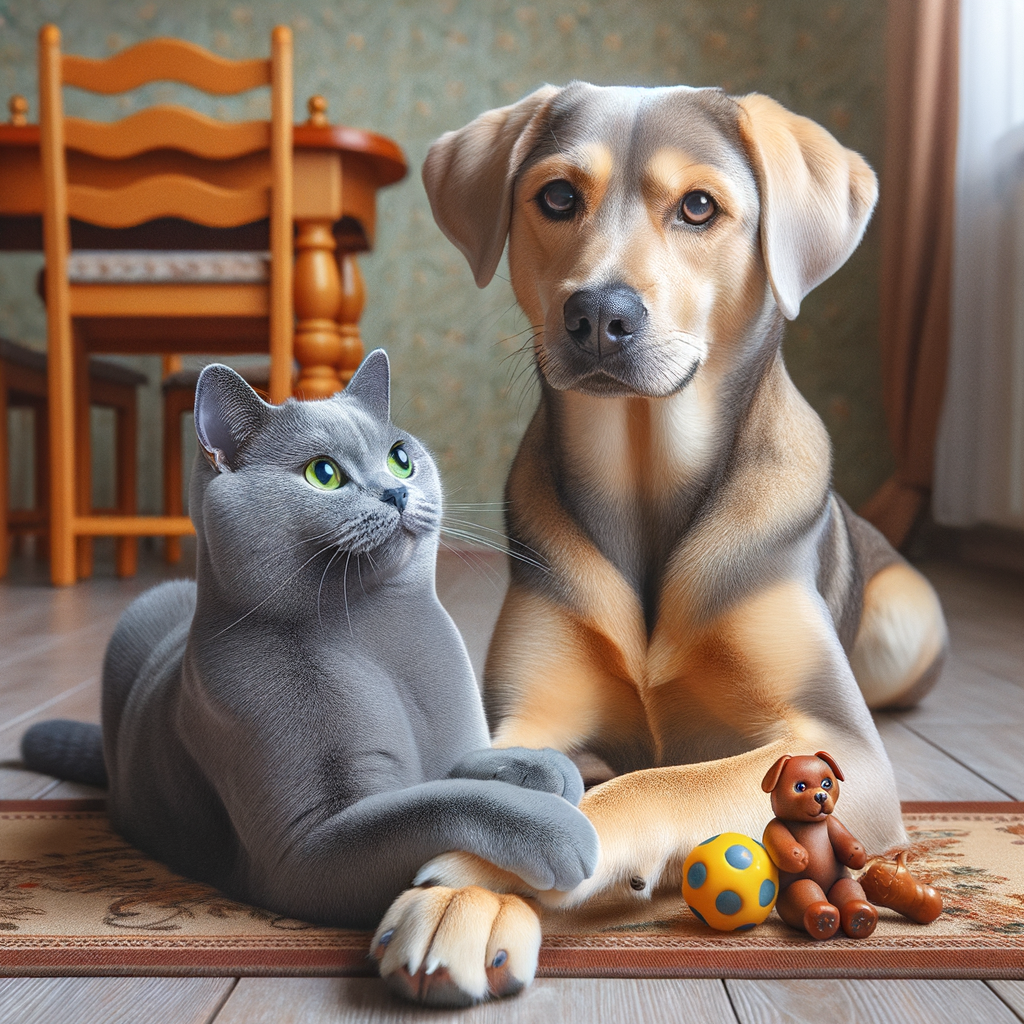
Russian Blue Cats: An Overview
When it comes to cats, the Russian Blue is a breed that stands out. Known for their striking appearance and charming personality, these cats have won the hearts of many. In this blog post, we’ll delve into the history, distinctive traits, and personality of Russian Blue cats.
- History and Origin of Russian Blue Cats
- Distinctive Traits of Russian Blue Cats
- Russian Blue Cats Personality
The Russian Blue cat, as the name suggests, originated in Russia. They are believed to have been the pets of Russian czars in the past. This breed was first shown at the Crystal Palace in London, England in 1875. They were known as the ‘Archangel Blues,’ named after the Archangel Isles in Northern Russia, where they were believed to have originated. Over the years, they have become popular worldwide due to their unique traits and personality.
Russian Blue cats are known for their short, dense coat of bluish-gray fur, which gives them their name. They have a muscular body with long legs and a wedge-shaped head. One of the most striking features of Russian Blue cats is their eyes, which are usually a vivid green color. They are medium-sized cats, typically weighing between 7 and 12 pounds.
Russian Blue cats are known for their gentle and quiet nature. They are often described as shy or reserved, especially around strangers. However, once they get comfortable, they can be quite playful and affectionate. They are intelligent and curious cats, often seen observing their surroundings or playing with toys. Russian Blues are also known for their loyalty and can form strong bonds with their human companions.
In conclusion, Russian Blue cats are a unique breed with a rich history, distinctive traits, and a charming personality. Whether you’re a cat lover or just someone interested in learning about different cat breeds, the Russian Blue is a breed worth knowing.
Inter-species Interactions: How Cats Interact with Dogs
Inter-species interactions, particularly between cats and dogs, are a fascinating topic. Despite popular belief, these two species can live together harmoniously. Understanding their behaviors, debunking common misconceptions, and recognizing the factors that influence their interactions are key to fostering a peaceful coexistence.
-
Understanding Feline and Canine Behavior
Cats and dogs have different communication styles. Dogs are pack animals, meaning they are social and thrive in groups. They use body language, facial expressions, and vocalizations to communicate. On the other hand, cats are solitary hunters who primarily use scent marking and body postures to communicate. Understanding these differences can help us interpret their interactions better.
For instance, a dog wagging its tail usually signals happiness, while a cat doing the same may indicate agitation. Recognizing these behaviors can prevent misunderstandings and potential conflicts.
-
Common Misconceptions about Cats and Dogs
One common misconception is that cats and dogs are natural enemies. This is not entirely true. While they have different communication styles and social structures, with proper socialization and training, they can live together peacefully.
Another misconception is that all dogs are dangerous to cats. This is also false. The behavior of a dog towards a cat largely depends on their individual personality, breed, and upbringing. Some dogs have a high prey drive and may see small animals as prey, while others are gentle and friendly towards cats.
-
Factors Influencing Inter-species Interactions
Several factors influence how cats and dogs interact. These include their individual personalities, past experiences, socialization, and training. For example, a dog that has been socialized with cats from a young age is more likely to get along with cats than a dog that has never encountered a cat before.
Similarly, a cat that has had positive experiences with dogs in the past will be more comfortable around dogs. Training also plays a crucial role. Teaching dogs to respect a cat’s space and teaching cats to feel safe around dogs can significantly improve their interactions.
In conclusion, understanding the behaviors of cats and dogs, debunking common misconceptions, and recognizing the factors that influence their interactions can help foster a peaceful coexistence. Remember, every cat and dog is unique, and their interactions will depend on their individual personalities, experiences, and training.
Russian Blue Cats and Dogs: A Unique Bond
When it comes to the animal kingdom, relationships between different species can be fascinating. One such unique bond is between Russian Blue cats and dogs. Let’s delve deeper into their interactions.
Russian Blue Cats Behavior Around Dogs
Russian Blue cats are known for their calm and friendly nature. They can form a strong bond with dogs if introduced properly. To understand their behavior around dogs, we need to observe their body language, understand their vocalizations, and study real-life examples.
- Observing Body Language
- Understanding Vocalizations
- Case Study: A Russian Blue and a Labrador
Body language is a primary way cats communicate. A relaxed Russian Blue cat around a dog might have its tail up, ears forward, and eyes half-closed. If the cat’s tail is puffed, ears flat, and eyes wide open, it might be scared or aggressive.
Along with body language, cats also use vocalizations to express their feelings. A Russian Blue cat might purr or meow softly when it’s comfortable around a dog. On the other hand, hissing or growling could indicate fear or aggression.
Consider the case of a Russian Blue cat named Bella and a Labrador named Max. Bella was initially wary of Max. However, with time and proper introductions, they became best friends. Bella’s body language and vocalizations changed from being scared to relaxed and friendly around Max. This case study shows that with patience, Russian Blue cats can form a unique bond with dogs.
In conclusion, understanding a Russian Blue cat’s behavior around dogs involves observing their body language and vocalizations. Every cat is unique, but with patience and proper introductions, Russian Blue cats can form a strong bond with dogs.
Dog-Friendly Cats: Are Russian Blues a Good Fit?
When it comes to finding a cat that can get along well with dogs, the Russian Blue is often a top choice. But how do you assess if a Russian Blue is truly a good fit for a household with dogs? Let’s explore.
- Assessing a Russian Blue’s Compatibility with Dogs
- Curiosity: Does the Russian Blue show interest in the dog, or do they seem scared?
- Body Language: A relaxed body and slow blinking are signs of comfort.
- Playfulness: If the cat engages in playful behavior with the dog, it’s a good sign they can coexist happily.
- Key Takeaways: Russian Blues as Dog-Friendly Cats
- Patience is key: Introductions should be slow and controlled. It can take time for a Russian Blue and a dog to become comfortable with each other.
- Monitor interactions: Always supervise interactions between the cat and dog, especially in the beginning.
- Provide safe spaces: Ensure the Russian Blue has places to retreat to if they feel overwhelmed.
First, it’s important to understand the personality of a Russian Blue. These cats are known for their intelligence, independence, and calm demeanor. They are not easily startled, which can be a great advantage in a home with dogs. However, each cat is unique, and it’s crucial to observe how a Russian Blue reacts to dogs before making a final decision.
Here are some things to look for:
So, are Russian Blues dog-friendly cats? The answer is generally yes, but it depends on the individual cat and dog, as well as how they are introduced and socialized. Here are some key points to remember:
In conclusion, Russian Blues can make a great addition to a dog-friendly home, given their calm and adaptable nature. However, it’s important to remember that every animal is unique and requires time and patience to adjust to new companions.
Creating a Harmonious Household: Tips for Introducing Russian Blue Cats to Dogs
Introducing a Russian Blue cat to a dog can be a challenging task, but with the right approach, it can lead to a harmonious household. Here are some steps to guide you through the process.
- Preparation: Setting the Stage for a Positive Introduction
Before the first meeting, it’s crucial to prepare both pets. For your Russian Blue, provide a safe space where it can retreat if it feels threatened. For your dog, ensure it’s well-exercised and calm. Use a baby gate or a similar barrier to separate them initially, allowing them to smell and see each other without direct contact.
- First Meeting: Guiding the Initial Interaction
During the first meeting, keep your dog on a leash and let your Russian Blue approach at its own pace. Reward calm behavior with treats or praise. Keep the first few interactions short and gradually increase the time as they get more comfortable with each other.
- Building the Bond: Encouraging Positive Pet Relationships
Building a bond between a Russian Blue cat and a dog takes time and patience. Encourage positive interactions by rewarding them when they are calm and relaxed around each other. Play games that involve both pets, or feed them at the same time on opposite sides of a door or gate. Over time, these positive experiences will help build a strong bond between them.
Remember, every pet is unique and may react differently. It’s important to go at a pace that’s comfortable for both your Russian Blue and your dog. With patience, understanding, and positive reinforcement, your pets can form a harmonious relationship.
| Steps | Description |
|---|---|
| Preparation | Provide safe spaces and ensure both pets are calm. |
| First Meeting | Keep the dog on a leash, let the cat approach at its own pace, and reward calm behavior. |
| Building the Bond | Encourage positive interactions, play games involving both pets, and feed them together. |
Understanding and Nurturing the Bond Between Russian Blue Cats and Their Canine Companions
Creating a harmonious relationship between your Russian Blue cat and your dog can be a rewarding experience. It’s all about understanding their interactions and addressing any potential issues promptly. Let’s delve into this fascinating topic.
Reading the Signs: Interpreting Russian Blue and Dog Interactions
Interpreting the interactions between your Russian Blue cat and your dog can give you valuable insights into their relationship. Here are some signs to look out for:
- Positive Interactions and What They Mean
- Addressing Potential Issues
Positive interactions between your Russian Blue cat and dog might include playful chasing, mutual grooming, or simply relaxing together. These behaviors indicate a strong bond and mutual respect. If your pets display these behaviors, it’s a sign that they feel safe and comfortable with each other.
However, not all interactions are positive. Signs of potential issues might include aggressive behavior, excessive hissing or growling, or one pet consistently avoiding the other. If you notice these signs, it’s important to intervene. This might involve separating the pets temporarily, providing additional training, or consulting with a pet behaviorist.
Remember, every pet is unique and will express their feelings in their own way. It’s crucial to observe and understand your pets’ individual behaviors to nurture a strong, positive bond between them.
Supporting a Strong Bond: Activities for Russian Blue Cats and Dogs
Building a strong bond between your Russian Blue cat and dog requires time, patience, and the right activities. Here are some activities that can help nurture this unique relationship:
- Interactive Play
- Shared Relaxation and Sleep Spaces
- Feeding Time: Encouraging Positive Associations
Interactive play is a great way to get your Russian Blue cat and dog to bond. Use toys that both animals can enjoy, like balls or laser pointers. This not only helps them get used to each other’s presence, but it also allows them to associate each other with fun and play. Remember, the goal is to make their interactions positive and enjoyable.
Allowing your Russian Blue cat and dog to share relaxation and sleep spaces can also help strengthen their bond. This shared space can be a cozy corner in your living room or a soft, comfortable bed. The key is to ensure that both animals feel safe and comfortable. Over time, they will start to associate this shared space with comfort and security, further strengthening their bond.
Feeding time can be a stressful event in a multi-pet household. To turn this into a bonding opportunity, try feeding your Russian Blue cat and dog at the same time but in separate bowls. This can help them associate feeding time with each other’s presence, creating a positive association. Over time, this can help reduce any food-related tension and promote a more harmonious relationship.
Remember, every cat and dog is unique. What works for one pair might not work for another. The key is to be patient and consistent. With time, your Russian Blue cat and your dog can form a strong, loving bond.







